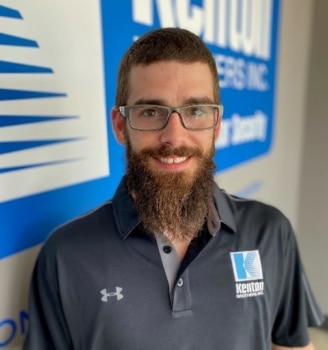By Kevin Whaley, CPP, Sr. Security Consultant at Kenton Brothers
 Welcome to Part 2 of Crime Prevention Through Environmental Design (CPTED). In Part 1, I introduced the concept of CPTED and the importance of ensuring CPTED principles are considered when developing or enhancing your security program.
Welcome to Part 2 of Crime Prevention Through Environmental Design (CPTED). In Part 1, I introduced the concept of CPTED and the importance of ensuring CPTED principles are considered when developing or enhancing your security program.
We touched on the four key overlapping concepts of CPTED which include:
- Natural Surveillance
- Natural Access Control
- Territorial Reinforcement
- Maintenance
For this part of the series, we will be diving into greater detail on the concepts of Natural Surveillance & Natural Access Control.
In order to successfully implement a CPTED plan of action, we must understand that all human space:
- Has some designated purpose
- Has social, cultural, legal, or physical definitions (such as expectations or regulations) that prescribe the desired and acceptable behaviors
- Is designed to support and control the desired and acceptable behaviors
With that understanding in mind, our approach should focus on:
- Manipulating the physical environment to produce behavior effects that reduce the fear and incidence of certain types of criminal acts;
- Understanding and modifying people’s behavior in relation to their physical environment
- Redesigning space or using it differently to encourage desirable behaviors and discourage illegitimate activities; and
- Reducing the conflicts between incompatible building users and building uses, with the goal of eliminating “no person’s land” that no one takes ownership of.
There are various controls that can be implemented to supplement or support the approaches listed above. However, before we dive into that, we need to understand the various concepts of CPTED in order to apply the approaches correctly.
Natural Surveillance
Natural surveillance is defined as the placement of physical features, activities and people in a way that maximizes visibility from the surrounding environment. Why does this matter? It increases the threat of apprehension by taking steps to increase the perception that people will be seen.
In other words, features that can maximize the visibility of people, parking areas, building entrances and other common use areas promote natural surveillance.
Example #1
As you can see in picture below, this site looks like it may be abandoned. If I were a “bad guy” I would probably think this looks like it doesn’t get a lot of attention from the workers or from the public. There are a lot of dark areas in which it would be very easy to remain undetected. Passers-by may not even notice it’s there.

Now here is that exact same location after applying basic CPTED principles. For this location, they added a significant lighting to greatly enhance visibility and eliminate hiding spots. Additionally, the large tree on the left was overgrown and actually growing OVER the roof. The tree was trimmed back to eliminate that avenue of opportunity.

Example #2
In this scene, you can see that the parking lot is barely visiible from the sidewalk, much less the street. The overgrown vegetation and low levels give bad guys plently of places to hide.

After doing some basic landscaping, they were able to greatly enhance the visibility of the parking lot and in doing so, actually helped improve illumination levels since lighting wasn’t being blocked by vegetation.

Inside/Outside
Keep in mind that when we talk about natural surveillance, that can apply to any environment and scenario. It’s not restricted to outdoor scenarios and encompasses much more than just lighting, landscaping etc. It can also include interior spaces such as lobbies, or other common areas. This means the way in which these areas are constructed or designed as well as any “decorations” that may be placed. It’s important to make sure that you are allowing for clear lines of sight as much as possible for natural surveillance.
Natural Access Control
Natural access control is a concept where people are physically guided through a space by the strategic design of streets, sidewalks, building entrances, and landscaping.
Similar to natural surveillance, don’t let “natural” lead to the misconception that this has to deal with just exterior design and landscaping. This pertains not only to the exterior of your building but interior as well.
There is public space and there is private space and sometimes the lines can be blurry. Natural access control fixes that by guiding people in and out of a space using signs, barriers, and other cues. When it is very clear where people should be, it becomes glaringly obvious when someone crosses that boundary into a place they should not be. And that attracts a lot of unwanted attention for a would-be criminal.
Most of us follow the cues that guide us from one place to the next: we walk on the sidewalk or pathway, we obey signs that say “No Trespassing” or “Parking Prohibited,” and we respect barriers, walls, locked doors, and fences designed to keep us out of a particular space. Ignore those “rules,” and you stick out. You’ve broken the silent agreement. Few things say, “I don’t belong here!” more than stepping off the marked path, lingering in a no-parking zone, or hopping over a fence.
And that’s natural access control doing its thing.
Pathways, signage, lighting, and borders—hedges, other plants, fences, and so on—let us direct the flow of foot traffic, which allows us to differentiate immediately between where people should and should not be.
Public space: good. Private space: suspicious.
Criminals want to blend in and disappear. Natural access control reduces, if not eliminates, their ability to do so.
Other design elements include:
- Single point of entry
- Restricted access to private, internal spaces with barriers, doors, and signage
- Sidewalks, roads, and pathways that funnel traffic into appropriate public spaces
- Barriers to prevent unauthorized use of spaces
- Low, open-type fencing that indicates private space, but does not prevent natural surveillance
- Eliminating design features that grant access to roofs or higher windows
- Locking windows and doors
- Thorny plants around first-floor windows and other potential points of access
We encounter natural access control all around us, just living our day-to-day lives. Most respect the cues they provide and take heed of the simple message. And when we don’t, that’s a giant red flag to others that something isn’t right. Combined with natural surveillance, natural access control makes it easy for everyone to identify suspicious behavior and note the individual doing it.
It’s good for you and your home or business. It’s bad for those looking for an easy target!

 By
By  Put a recurring reminder on your calendar to replace batteries.
Put a recurring reminder on your calendar to replace batteries. Point out system devices and cabling to contractors when remodeling to prevent damage or system interruption.
Point out system devices and cabling to contractors when remodeling to prevent damage or system interruption. A customer, Rich, recently came to us with a problem. His access control environment has three generations of
A customer, Rich, recently came to us with a problem. His access control environment has three generations of  Creating a training wall with four different boards and two doors per board would take up a lot of room and be fairly costly. We ended up creating two demonstration doors where they could be switched to one of the four access control boards. One of the doors we set up as fail-secure, meaning the door is still locked if power is removed. The other door was set up as fail-safe, meaning the door is unlocked when the power is removed. We did this to demonstrate the different ways of connecting the power supply and to provide a realistic scenario that might be found in the field.
Creating a training wall with four different boards and two doors per board would take up a lot of room and be fairly costly. We ended up creating two demonstration doors where they could be switched to one of the four access control boards. One of the doors we set up as fail-secure, meaning the door is still locked if power is removed. The other door was set up as fail-safe, meaning the door is unlocked when the power is removed. We did this to demonstrate the different ways of connecting the power supply and to provide a realistic scenario that might be found in the field.








